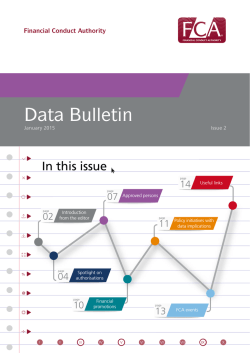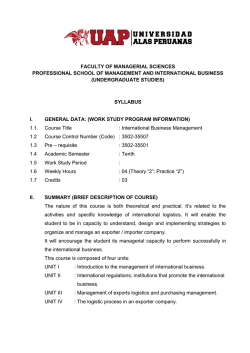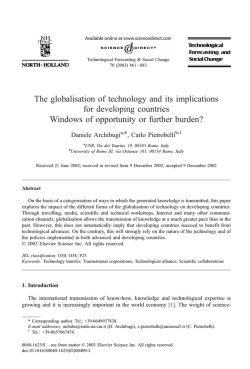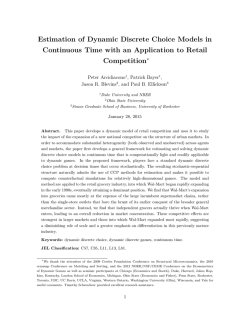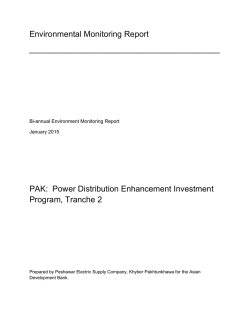
[1] Musleh-ud Din
© The Pakistan Development Review 48 : 3 (Autumn 2009) pp. 227–240 Determinants of Export Performance of Pakistan: Evidence from the Firm-Level Data MUSLEH UD DIN, EJAZ GHANI, and TARIQ MAHMOOD* This paper explores the determinants of export performance at the level of firms in respect of their characteristics and supply side constraints. The analysis is based on a survey of export-oriented firms in four major sectors. The results indicate a relationship between the better performance of foreign-owned firms to their better know-how and resources compared to the domestically owned firms. Export performance is positively affected by the level of investment in market/client oriented technologies. Lack of certification of product and process standards is the main supply side constraint adversely affecting the firms’ export performance. Facilitation measures like export processing zones, internationally recognised testing labs, and industrial clusters would be helpful in improving the export performance of firms. JEL classification: F1, L1, L6 Keywords: Trade, Exports, Firms, Performance, Manufacturing 1. INTRODUCTION Exports are widely believed to play a crucial role in the development process. Access to the global market allows domestic firms to achieve economies of scale and thus enhance their profitability. Being a source of foreign exchange earnings, higher exports enable a country to meet its growth and development needs through import of capital goods and raw materials. Exports lead to an improvement in economic efficiency by increasing the degree of competition; and contribute to productivity gains through diffusion of technical knowledge and learning by doing.1 Export-led growth of East Asian countries and the recent growth achievements of India and China through their integration with global markets has brought export promotion to the forefront in development policy agendas of most developing countries. Despite vigorous efforts to promote exports, Pakistan’s exports as a proportion of its GDP have made no significant gains over the years with the country’s share in global exports standing at a meagre 0.13 percent. In order to understand why Pakistan’s exports have failed to pick up despite favourable export policies, this paper analyses the determinants of export performance at the level of firms in terms of their specific characteristics and supply side constraints. The analysis is based on a survey of exportMusleh-ud Din <[email protected]> is Joint Director at the Pakistan Institute of Development Economics, Islamabad. Ejaz Ghani <[email protected]> is Chief of Research at the Pakistan Institute of Development Economics, Islamabad. Tariq Mahmood <[email protected]> is Senior Research Economist at the Pakistan Institute of Development Economics, Islamabad. 1 Krugman (1984). Din, Ghani, and Mahmood 228 oriented firms conducted by the Pakistan Institute of Development Economics (PIDE) with the collaboration of United Nations Industrial Development Organisation (UNIDO).2 During the last couple of decades there has been a growing interest among empirical researchers to investigate the determinants of export performance at the firm and industry levels.3 There are three main reasons for this shift in focus from macro to micro level. First, there are theoretical reasons to believe that firms’ characteristics are important in international trade. Traditional trade theories like the Ricardian theory of comparative advantage and Heckscher-Ohlin model of comparative advantage assume homogeneous firms within an industry. However, new trade models following the seminal work of Krugman (1980) assign explicit role to the characteristics of firms, mainly because it is at the firm level that actual production and trade decisions are made. Other developments such as out-sourcing and multinational production practices have also brought the firm at the centre of international trade theory. Second, globalisation and rapid increase in the means of communication have enabled even relatively smaller firms to target niche markets for higher profits, and this has led researchers to study how firms’ characteristics are related to export performance. Third, availability of micro data sets and better computation techniques has facilitated micro-level empirical research. All these factors have raised the importance of firms’ characteristics in international trade literature. The role of internal and external factors in export performance is a relatively less explored area of empirical research in Pakistan. At the macro level, Akbar and Naqvi (2001) find that Pakistan’s export performance is sensitive to both domestic and external market conditions, particularly in the area of competivity. However the authors find that it is relatively more sensitive to demand-side variables than to other factors. At the micro level, Masakure, Henson, and Cranfield (2009) assess the effects of quality certification on export sales and share of exports for Pakistan’s exporting firms using the Logit model while treating certification as a binary dependent variable. The results indicate a positive correlation between export performance and ISO 9000 certification, implying that the latter plays a key role in establishing exporters’ credibility and bringing performance gains. The present study differs from Masakure, Henson, and Cranfield (2009) in two important ways. First, it explicitly treats firms’ characteristics as explanatory variables while treating exports per labour as an endogenous variable. Second, it regards certification as a supply constraint from the exporters’ perspective which is measured on the Likert scale. By using exports as a dependent variable, the present study promises to shed more light on the question of how export performance of firms is influenced by their characteristics as well as supply side constraints directly as against quality certification as in Masakure, Henson, and Cranfield (2009). The rest of the paper is organised as follows. Section 2 provides a brief review of the literature. Section 3 describes the survey data and provides a brief profile of exporting firms included in the survey. Section 4 sets out the methodology, whereas Section 5 discusses the empirical results. Section 6 spells out conclusions and policy implications. 2 3 See PIDE (2007). See Madsen (1987) and Aaby and Slater (1989) for a survey of this literature. Determinants of Export Performance of Pakistan 229 2. REVIEW OF LITERATURE A growing body of literature has focused on analysing export performance at the firm level using a variety of techniques and data sets. Such works have been reviewed quite extensively in the literature; see for example, Aaby and Slater (1989), Madsen (1987), Zou and Stan (1998), and Sousa and Alserhan (2002). This section offers a brief review of some recent studies on the subject. Yoshino (2008) analyses how the different characteristics of African manufacturing firms and the various domestic supply constraints influence the pattern of geographical diversification of their exports. The study uses firm-level data from World Bank Investment Climate Survey (ICS) of the manufacturing sectors of seven SubSaharan African countries. The bivariate analysis is performed to explain geographical orientation and market diversification, and the results indicate a positive correlation between export intensity and market diversification measured as the number of export markets the firms serve. Tobit models of firm-level export intensity and market diversification are also used which indicate that the size, foreign ownership, and technology are the dominant factors in explaining firm-level export performance. Laursen (2008) explores the determinants of firm-level export behaviour for Danish industries. The study uses a data set consisting of 1,873 Danish firms in manufacturing and services using the share of their exports in their total sales as a measure of their export performance. A Tobit model has been used to estimate the regression equation with age, number of employees, and fixed assets as independent variables. The model also includes some variables relating to the source of innovation such as suppliers, customers and universities. The findings support the idea that innovative techniques are determinants of export behaviour particularly in relation to customers. Process innovation and using suppliers as a source of knowledge for innovation have a negative relationship with export intensity. This has been taken to be the case when Danish manufacturing and service firms have been at a disadvantage in cost competition. Wignaraja (2007) analyses firm-level export performance of clothing enterprises in Sri Lanka. The data are taken from the Asian Development Bank/World Bank investment climate survey of urban and rural enterprises in Sri Lanka, conducted in 2004. Export-tosales ratio has been used as a measure of export performance which appears as the dependent variable in a Tobit model. Explanatory variables include ownership, firm size, human capital, technological capabilities, and geographical location. The results indicate that size, foreign ownership, technology index and the human capital variables have positive and significant effect on export performance. Similarly a dummy variable for geographical location also turns out to be positive and significant, indicating that firms located close to Colombo have an export advantage due to lower transport costs and other locational externalities. Dueñas-Caparas (2006) analyses export performance of manufacturing sectors in the Philippines. Firms are classified in three major sectors, viz., Food, Clothing, and Electronics. The study uses data from the firm-level survey conducted in 2002 by the Asian Development Bank (ADB) in collaboration with the World Bank and the Philippines National Statistics Office. The study uses a modified quasi-maximum likelihood procedure to specifically address the issue of fractional responses. Export 230 Din, Ghani, and Mahmood performance is defined as export to sales ratio which is used as a dependent variable in the model. Independent variables include age, size (defined as the number of employees), share of skilled workers to total workers, share of research and development expenditure to total sales, and the ratio of capital stock to labour cost. Dummy variables are used to estimate the effects of training and ownership (domestic vs. foreign). It is found that foreign ownership, training, and research and development positively affect export performance in all industries in the sample. Capital per worker is found to positively influence the export performance of electronic firms but not in the clothing and food processing sectors. A nonlinear relation between size and export performance is found in all firms, most significantly in the clothing sector. This suggests that as firms expand, they gain in their export performance. However, further expansion after a certain level results in less than the desired outcome in export performance. Smith, et al. (2002) analyse the role of research and development in the export behaviour of Danish firms. The study uses a data set for 3,500 Danish firms for the year 1997, obtained from the official Danish Research and Development (R&D) Statistics. The study is concerned with the interaction between the firms’ R&D decisions and the export performance as well as other influencing factors. Specifically, the firm’s age and size, labour cost, human capital and the firm’s financial solvency are taken as key determinants of export behaviour. The study uses a bivariate Probit specification and through the maximum likelihood technique estimates a simultaneous model for export orientation and investments in R&D. The results show that the likelihood of being an exporter and investment in R&D positively depends on firm size and age. The export orientation is also found to depend positively on the firm’s financial solvency. The effect of wage share on exports turns out to be negative. The decision to invest in R&D is found to be high in concentrated industries and low among industries with high entry barriers. Bhavani and Tendulkar (2001) investigate export performance of Garment and Apparel firms located in Delhi (India). The study estimates the export performance and export decision functions using the census of small-scale industrial units. For export decision function, a Probit model is estimated using the scale of operation, sales expenses and the form of business organisation as independent variables. The export performance function is estimated by Tobit model. The ratio of exports to production is taken to represent the export performance which is used as a dependent variable. Independent variables include the value of production, technical efficiency index, ratio of wage bill to production, and the share of sales and other expenses in production. The results of the export performance equation indicate that the value of production, technical efficiency index, and the share of sales and other expenses in production have a positive effect on export performance, whereas the ratio of the wage bill to production and types of ownership viz., single proprietorship or partnership, show a negative impact. The study provides two important policy implications. First, in view of the importance of scale, it wants the existing policy of reserving garments and apparel for exclusive production in small-scale units scrapped and second, recommends amendment in the labour legislation applicable to large-scale factory units as it makes labour markets inflexible and becomes an impediment to the expansion of existing units and the entry of new ones. Determinants of Export Performance of Pakistan 231 In their study of Pakistan’s economy, Masakure, Henson, and Cranfield (2009) use a Logit model to explore the effects of quality certification on export sales and the share in exports of firms using certification as a binary dependent variable. The results indicate a positive correlation between export performance and ISO 9000 certification, implying that the certification plays a significant role in export performance of the firms through enhancement of their credibility in international markets. It is important to note here that the study does not provide a direct evidence of the role of characteristics and supply side constraints in the export performance of the firms, a question that is being explored in the present study. 3. SURVEY DATA AND PROFILE OF EXPORTERS The study is based on a survey of exporters in the provinces of Punjab and Sindh. The survey was conducted by the Pakistan Institute of Development Economics (PIDE) with the collaboration of United Nations Industrial Development Organisation (UNIDO). The survey focused on four major exports of Pakistan, viz., textiles/apparel, leather, agrofood processing and fisheries.4 Each of these sectors comprises various sub-sectors (Table 1). Textiles comprise yarn, fabrics, knitwear, garments, bed sheets and towels; leather comprises tanning, footwear and leather products; agro-food group includes processing, horticulture products, and rice; and the fisheries comprise various types of fish processing enterprises and fish exporters. Table 1 Sectoral Coverage Textile/Apparel Leather • Yarn • Tanning • Fabric • Footwear • Garments • Leather products/ garments • Knit wear • Bed sheets and Towels Agro-food Processing • Horticulture products (fruits and vegetables) • Rice (grading and polishing) Fisheries • Fish processing enterprises • Fish exporters As a first step, a list of all exporters in the four sectors was compiled.5 In line with the survey objectives it was decided initially that the universe would consist of exporters with 50 or more employees. However, except for the textiles mills identified by the All Pakistan Textiles Mills Association (APTMA), which are generally large-scale enterprises, the information on the number of employees was not available. Hence an alternative criterion of determining the size of an enterprise was adopted for firms other than textiles enterprises listed with APTMA, and that was to focus on enterprises having exports of Rs 1 million or more. The presumption here is that the higher the export value, the larger would be the scale of the enterprise.6 4 Textiles, agro-food and leather were chosen because there are the major exporting sectors. Fishery was chosen because its potential to become a major exporting sector. 5 There were some 1357 exporting enterprises in this list with 607 in textiles and apparel, 363 in leather sector, 308 in agro-food processing and 16 in fisheries. 6 As the final criterion for selection was export value rather than the number of employees, the sample also includes enterprises with less than 50 employees. 232 Din, Ghani, and Mahmood Using the stratified random sampling approach, a total of 180 firms were chosen covering the four major export categories (Table 2). The enterprises in the four sectors were stratified according to the sub-processes listed in Table 1. Table 2 Sectors Textiles/Apparel Leather Fisheries Agro-food Total Sectoral Distribution of Firms Number of Enterprises Percentage in Total Sample 90 50 45 25 16 10 29 15 180 100 The number of firms in each stratum (sub-process) was chosen roughly on the basis of the share of exports of each sub-sector in the corresponding sector. For instance, the number of firms in yarn was chosen on the basis of the share of yarn in total exports in the textiles group. The universe column indicates the total number of firms in each sector and sub-sector meeting the size criteria from which the sample was drawn. The details are as follows (Table 3). Table 3 Sector-wise Sample and Universe Enterprises in the Sample Textiles/Apparel Yarn Fabrics Garments Knit Wear Bed Sheets and Towels Total Leather Tanning Footwear Leather Products/Garments Total Agro-food Processing Horticulture Products (Fruits and Vegetables) Rice (Grading and Polishing) Total Fisheries Universe 14 24 16 16 20 90 64 54 48 27 33 226 19 7 19 45 19 7* 62 88 7 22 29 22 43 65 16 16 *There were only seven firms having exports of Rs one million or more. Therefore, all the seven firms were included. Determinants of Export Performance of Pakistan 233 The age distribution of firms (Table 4) reveals that the majority of firms (62 percent) were less than 25 years old in 2005. For domestic firms the percentage is 64 and for foreign firms it is 52. The number of entrants (domestic as well as foreign) has been highest in the period 1990-1999. Incidentally, there has been no entry of foreign firms in the period 2000-2005.7 Table 4 Percentage Distribution of Firms by Age and Ownership Year of Establishment Total Domestic Foreign Up to 1947 4.1 2.4 13.0 1947-1959 7.5 8.1 4.4 1960-1969 11.6 10.5 17.4 1970-1979 15.0 15.3 13.0 1980-1989 21.1 21.8 17.4 1990-1999 29.9 29.0 34.8 2000-2005 10.9 12.9 0 Source: Survey data. The size distribution of firms shows that a majority of firms employ more than 99 employees and hence fall in the category of large firms8 (Table 5). At the sectoral level, the textile sector mostly consists of large firms, whereas in agro-food and fishery smaller firms dominate. Table 5 Percentage Distribution of Firms by Employment Textiles Leather Agro-food Less than or Equal to 49 3.3 4.1 5.7 From 50 to 99 3.3 9.8 5.7 From 100 to 249 9.8 4.9 4.1 From 250 to 999 16.4 3.3 2.5 Greater than or Equal to 1000 13.9 1.7 0 Fishery 1.6 4.1 4.9 0.8 0 Total 14.8 23.0 23.8 23.0 15.6 Source: Survey Data. Location is an important determinant of firms’ export performance. Karachi, being the largest industrial city and a hub of exporting activities, accounts for the highest proportion of firms in the sample, followed by Lahore and Sialkot (Table 6). Together, these three cities account for more than 80 percent of firms under study. 7 In fact, net inflow of foreign direct investment gained momentum in the year 2005-06 and peaked in 2007-08 at about US$5.2 billion. This phenomenon is very prominent in “Food, Beverages and Tobacco” sector where net foreign direct investment registered manifold increase (Pakistan Economic Survey 2007-08). The FDI started declining in later years: FDI was US$3.2 billion in 2008- 09 (Pakistan Economic Survey 2008-09) and further fell to US$1.8 billion during the period July to April 2009-10. Pakistan Economic Survey (2009-10). 8 This line of division has been used in literature; see for example Wignaraja (2007). Din, Ghani, and Mahmood 234 Table 6 City of Location Karachi Lahore Multan Sialkot Wazirabad Faisalabad Kasur Others Percentage Distribution of Firms by Location Percentage of Firms 54.1 20.4 3.2 12.1 1.3 5.1 1.3 2.4 Source: Survey Data. Trends in Sales In the textiles sector, the average sales of firms increased over time (2000-2004) for firms of all sizes except for smaller firms with up to 50 employees. Firms with 50-99 employees witnessed a six-fold increase in their sales during the period 2000-2004, increasing from US$ 1141.2 thousand in 2000 to US$ 6852.9 thousand in 2004. It is interesting to note that firms with 100-249 employees had lower sales than smaller size firms (50-99 employees). This is essentially due to aggregation of sales because the problem does not exist at the sub-sector level. The sales of larger size firms also witnessed robust growth during 2000-2004. The sales of leather firms of all sizes generally exhibited a declining trend during the period. The only exception was very high sales in the years 2001 and 2002 due to strong growth, in one company particularly. In the agro-food sector, while the sales of firms with less than 1000 employees showed a fluctuating trend, the sales of firms with 250-999 employees registered manifold increase during the period, from US$ 6276 thousand in 2000 to US$ 39170 thousand in 2004. Except for fish exporters with 250-999 employees who witnessed an increase in their exports during the period, other exporters in this sector reported either declining or sluggish sales over time. Distribution of Sales by Domestic and Foreign Markets A majority of firms in all sectors were largely export-oriented: total exports as percentage of total sales ranged from 80 percent to 100 percent in all sectors. This is hardly surprising in view of the fact that our sample is focused on firms that are export firms. However, there are a large number of firms that may be selling their products exclusively in domestic markets. That the export firms also sell in the domestic market is a positive trend that may result in the local consumer getting better quality products. Export Diversification by Markets The European Union is a major market for textiles and leather exporters, followed by North America and Asia.9 For agro-food exporters, North Africa and Middle East are 9 Within the textiles sector, Asia is a major market for yarn and fabrics, besides EU and North America. Asia is also a major market for exports of tanneries. Determinants of Export Performance of Pakistan 235 the major markets, followed by Asia, EU and North America. Most of the fisheries exports are marketed in Asia, followed by EU, North Africa and Middle East, and North America. It is clear that Pakistan’s exports are concentrated in a few markets, and, therefore, there is an urgent need for exploring new markets for Pakistani products. The exporters indicated the desire to diversify the export markets towards Africa, Middle East and Latin America. Nevertheless, the traditional markets would continue to play a major role. For example, the majority of textiles exporters accorded high priority to EU as a future market followed by North America. Only a few textiles exporters indicated a high priority for Asia as a future market. However, it was suggested that Pakistan would focus on the Chinese market in Asia to exploit its potential. North America emerged as a high priority future market for leather exporters, followed by EU, Latin America, the Caribbean, and Asia. About half of agro-food exporters attached high priority to EU as a future market, followed by Asia. A majority of fisheries exporters indicated high priority for EU, North America and Asia as future markets. 4. METHODOLOGY In a pioneering study on export performance of firms, Aaby and Slater (1989) define two broad categories of variables that can influence their export performance: (a) external factors which mainly determine the environment under which firms are operating, and (b) firm characteristics and strategy which are internal to the firm. In this study we focus on the latter. Firms’ performance is measured by the value of exports in US dollars. To control for the firm size, the dependent variable is defined as the value of exports per unit of labour employed (Exp). The independent variables include age, type of ownership, investment in product and process technologies, managerial competence, certification of product and process standards, and location. The complete regression equation is specified below.10 Expi = β0 + β1 Agei + β2 Ownershipi + β3 DInvesti + β4 DFinvi + β5 Ceri + β6 DLoc + ui The variable ‘Age’ represents the number of years of establishment of the firm. This variable may affect export performance of the firm in different ways and its sign is theoretically ambiguous. For example, this variable could have a positive sign if older firms being more experienced are able to demonstrate better export performance. On the other hand, one could argue that new firms, having a modern outlook with better management and production techniques, may be more efficient and thus may show better export performance. The evidence in the empirical literature is mixed. Smith, et al. (2002) and Barrios, et al. (2003) find a positive sign for the age coefficient, but Ramstetter (1999) and Sjoholm (2003) report a negative coefficient for the age variable. ‘Ownership’ is a dummy variable to control for the type of ownership. The dummy variable takes a value of 1 for firms with domestic ownership and a value of zero for foreign ownership. Firms with foreign ownership are expected to perform better than domestic firms due to better technical and managerial expertise, greater access to and networking with foreign markets. In the literature, the evidence is in favour of foreign10 As pointed out by a referee, the model specification may be subject to endogeneity bias. The problem of endogeneity is pervasive in economic research, and it is difficult to handle, especially in survey data that are inherently limited in scope, making it hard to use appropriate instruments. 236 Din, Ghani, and Mahmood owned firms: for example, Ramstetter (1999) and Wignaraja (2007) find that foreignowned firms outperform domestic-owned firms in export markets. The ownership variable, therefore, is expected to have a negative sign. Investments by firms to improve their product and market strategies and to strengthen networking with clients are expected to play an important role in determining their export performance. The surveyed firms were asked about their level of investment during the last three years, and the average of these yearly investments is used as an explanatory variable (DInvest). Firms with investment in client/market oriented technologies are expected to outperform those who made no such investment. Therefore, this variable is expected to have a positive sign. Managerial competence strongly affects a firm’s performance. A competent management has a long term horizon, is well aware of markets and new challenges, and is better able to cope with present and future challenges. Unfortunately, data on managerial competence are not available. We have thus tried to proxy this variable by a binary variable (DFinv) that captures the firms’ responses to their future investment plans. It is plausible to assume that a competent management will be aware of the available investment opportunities and will have prepared future investment plans in line with the market outlook. The variable assumes a value of 1 if a firm has prepared such a plan, and zero otherwise. On a priori grounds, we expect this variable to have a positive coefficient. The capacity challenges on the supply side faced by the firms can significantly influence their export performance. In the survey, the firms were asked to use Likert scale responses (ranging from 0= ‘not applicable’ to 5 ‘major problem’) to indicate how a particular supply constraint applied to their firms. A major constraint identified by the firms was the lack of certification of products and process standards and consequently this variable was included in the model. Certification of conformity with standards and technical regulations is intended to ensure uniformity of products and processes and to ensure minimum safeguards on quality and safety. More and more international buyers ask for the proof that internationally recognised (certified) operational systems and procedures were in place for quality process and product management. The performance of exporters not having international certifications is likely to be hampered owing to their inability to demonstrate compliance with international product and process standards and technical regulations. We, therefore, expect a negative sign for this constraint. Location of firms is also an important determinant of firm performance. Firms that are located at a geographically advantageous position in terms of both logistics and industrial clusters are expected to perform better than firms that do not possess these locational advantages. For example, proximity to a port can help the firm improve its performance through rapid delivery of imported inputs, timely export shipments, and lower transportation costs. On the other hand, firms located in industrial clusters enjoy various positive externalities including availability of business-related amenities and infrastructure. To capture these advantages, a dummy variable is used that assumes a value of 1 if a firm is located in Karachi, and zero otherwise. Because of the locational advantages, it is expected that firms that are located in Karachi would exhibit a better export performance than firms located elsewhere. Determinants of Export Performance of Pakistan 237 5. EMPIRICAL RESULTS The estimation has been performed by Ordinary Least Squares technique. In order to avoid the problem of heteroskedasticity, White’s Consistent Standard Errors and Covariance Procedure has been used. This technique is preferred in cross-section data that include variables relating to the ‘size’ aspects of firms. In such cases, the error term may also pick up variations due to size, possibly because of some omitted variables in the model.11 In the context of the present study, variables such as exports and investment are related to the size of the firm and hence the data are susceptible to the problem of heteroskedasticity. The results of estimation of coefficients of variables along with their standard errors, t-values and probability of rejection (i.e., probability of rejection of null hypothesis that the coefficient of a specific variable is zero) are given in Table 7. The Fstatistics are significant implying that selected variables significantly explain export performance of firms.12 Table 7 Regression Results Dependent Variable: Exports per Unit of Labour (Exp)* Method: Least Squares White Heteroskedasticity-Consistent Standard Errors and Covariance Variable Coefficient Std. Error t-Statistic C 2.2211 0.5220 4.2549 Age –0.0005 0.0057 –0.0904 Ownership –0.7436 0.4170 –1.7829 DInvest 0.0510 0.0049 10.3078 DFinv 0.9628 0.2853 3.3747 Cert –0.5759 0.2198 –2.6204 DLoc 0.6191 0.3576 1.7312 R-squared 0.5593 F-statistic Adjusted R-squared 0.4334 Prob. (F-statistic) Prob. 0.0004 0.9288 0.0891 0.0000 0.0029 0.0160 0.0981 4.4421 0.0047 * Dependent variable in natural log. The results show that the age of the firm has a negative but insignificant effect on firms’ performance.13 The dummy variable for ownership is negative and significant, implying that foreign-owned firms exhibit superior export performance than the domestically owned firms.14 It is generally accepted that foreign-owned firms possess better managerial and technical expertise and are better able to meet the global market requirements through their international linkages.15 This result underscores the fact that 11 See Cooper and Weekes (1983), p. 217. As suggested by a referee, we have tried sectoral dummies but the results are amenable to any useful interpretation. 13 This is similar to the finding by Masakure, et al. (2009). 14 Other empirical studies have found similar results for developing countries; see, for example, Bhavani and Tendulkar (2001), Dueñas-Caparas (2006), and Wignaraja (2007). 15 See Baldwin and Gu (2003). 12 Din, Ghani, and Mahmood 238 the domestic firms can also compete effectively in international markets provided they upgrade their managerial and technical competencies and build international networks as demonstrated by foreign-owned firms. There is a positive and highly significant relationship between the level of investment in product and process technologies and export performance. Higher investment in product quality as well as in production processes allows the firms to capture export markets and improve their profit margins.16 Similarly, managerial competence has a positive and significant impact on export performance. Firms that possess better managerial expertise are more attuned to market dynamics and hence are able to perform better in export markets. The lack of certification turns out to be an important supply side constraint that adversely affects the firms’ export performance.17 The dummy variable for firms located in Karachi is positive and significant and this shows that such firms enjoy the benefits of proximity to port and industrial clusters. 6. CONCLUSIONS AND POLICY IMPLICATIONS This paper has investigated the determinants of export performance at the firm level, based on a survey of export-oriented firms in four major export segments including textiles and apparel, leather products, agro-food, and fisheries. The results of the regression analysis indicate that foreign-owned firms outperform the domestic firms in export markets, not least because of the formers’ advantages in terms of better managerial and technical expertise and networking with international clients. The export performance of firms is positively influenced by the level of investment in market/client oriented technologies. This underlines the importance of strengthening marketing networks and upgrading products and process technologies in line with the latest market requirements. Managerial competence also turns out to be an important determinant of export performance highlighting the importance of this factor in gaining access to highly competitive export markets. Lack of certification of compliance to international product and process standards is a major supply capacity constraint hindering export performance of the firms. Firms located in geographically advantageous areas with strong industrial clusters and easy access to international transportation exhibit better export performance as compared with firms that do not enjoy these advantages. The above findings have important policy implications. First, foreign direct investment in export-oriented industries can play an important role in boosting Pakistan’s exports. Pakistan offers attractive incentives to foreign investors but so far it has not been able to attract significant investments, especially in export-oriented industries. A step in the right direction has been the establishment of export processing zones in major cities that are designed to cater to the specific needs of export-oriented firms18. However, there is a need to make these zones more attractive to foreign investors by providing them with better physical infrastructure and utilities. 16 Alvarez and Lopez (2005) find such investments to be highly significant in influencing performance of exporters. 17 Various other supply side constraints—including lack of skilled labour, inability to meet market requirements, problem on on-time deliveries—were tried but these turned out to be insignificant. 18 A variety of incentives are offered to investors in the export processing zones including duty and tax free import of machinery, equipment and materials. Determinants of Export Performance of Pakistan 239 Second, it is important to facilitate the certification of compliance to international product and process standards. There is a dearth of internationally recognised testing laboratories in Pakistan that can cater to certification needs and consequently exporters have to rely on testing laboratories in Singapore, Hong Kong, UK, Germany and other countries making the whole process costly. There is, therefore, a need to help develop internationally recognised and accredited local testing laboratories to cater to the testing needs of textile, leather, agro-food and fisheries sectors. Also, there is a need to raise the level of awareness among exporters about the importance of certification. Finally, the results underscore the importance of advantages of location and clustering in export performance of the firms. Businesses thrive and grow in clusters which help the firms in lowering their costs through easy access to amenities and other business-related facilities that are typically available in such clusters. In this respect, an important initiative is the concept of Textiles City being developed in the industrial area of Karachi’s port Qasim which can be an important inducement for export-oriented firms. There is a need for more such initiatives to help cluster export-oriented manufacturing, allowing the firms to benefit from agglomeration economies. REFERENCES Aaby, Nils-Erik and Stanley F. Slater (1989) Management Influences on Export Performance: A Review of the Empirical Literature 1978-1988. International Marketing Review 6:4, 7–26. Akbar, Mohammad, and Zareen F. Naqvi (2001) External Market Conditions, Competitiveness, Diversification, and Pakistan’s Export Performance. The Pakistan Development Review 40: 4, 871–884. Alvarez, R. E. and R. A. Lopez (2005) Exporting and Performance: Evidence form Chilean Plants. Canadian Journal of Economics 38:4, 1384–400. Baldwin, J. R. and W. Gu (2003) Export Market Participation and Productivity Performance in Canadian Manufacturing. Canadian Journal of Economics, 36:3, 634– 657. Barrios, S., H. Görg, and E. Strobl (2003) Explaining Firms’ Export Behaviour: R&D, Spillovers and the Destination Market. Oxford Bulletin of Economics and Statistics 65:4, 475–496. Bhavani, T. A. and S. D. Tendulkar (2001) Determinants of Firm-level Export Performance: A Case Study of Indian Textile Garments and Apparel Industry. Journal of International Trade and Economic Development 10:1, 65–92. Cooper, R. A. and A. J. Weekes (1983) Data, Models and Statistical Analysis. Deddington, Oxford: Philip Allan Publishers. Dueñas-Caparas, Ma. S. Teresa (2006) Determinants of Export Performance in the Philippine Manufacturing Sector. Philippine Institute for Development Studies. (Discussion Paper Series No. 2006-18). Krugman, P. (1980) Scale Economies, Product Differentiation, and the Pattern of Trade. American Economic Review 70:5, 950–959. Krugman, P. (1984) Import Protection as Export Promotion. In Henryk Kierzkowski (ed.) Monopolistic Competition and International Trade. pp. 190-93. Oxford: Oxford University Press. 240 Din, Ghani, and Mahmood Laursen, Keld (2008) The Effect of Knowledge Sources for Export Performance in Manufacturing and Services: Danish Firm-level Evidence. DRUID, Department of Innovation and Organisational Economics, Copenhagen Business School. Paper prepared for the ICONS (Innovation and the International Competitiveness of Nordic Services) Project. Madsen, Tage Koed (1987) Empirical Export Performance Studies: A Review of Conceptualisations and Findings. pp. 177–198. In S. Tamer Cavusgil (ed.) Advances in International Marketing. JAI Press. Masakure, O., Henson, and J. Cranfield (2009) Standards and Export Performance in Developing Countries: Evidence from Pakistan. The Journal of International Trade and Economic Development 18:3, 395–419. Pakistan, Government of (2008) Pakistan Economic Survey. Islamabad: Finance Division, Economic Adviser’s Wing. PIDE (2007) Trade Related Challenges Facing Exporters in Pakistan. Islamabad: Pakistan Institute of Development Economics. Ramstetter, E. (1999) Trade Propensities and Foreign Ownership Shares in Indonesian Manufacturing. Bulletin of Indonesian Economic Studies 35. Sjoholm, F. (2003) Which Indonesian Firms Export? The Importance of Foreign Networks. Papers in Regional Sciences 82, 333–350. Smith, V., et al. (2002) Do R&D Investments Affect Export Performance? The Centre for Industrial Economics, Department of Economics, University of Copenhagen, Denmark. (CIE Discussion Paper 2002-09). Sousa, Carlos M. and Bakr A. Alserhan (2002) An Investigation into the Antecedents of the Export Performance Literature. 28th EIBA Conference Athens University of Economics and Business Athens, Greece 8-10 December. Wignaraja, Ganeshan (2007) Foreign Ownership, Technological Capabilities, and Clothing Exports in Sri Lanka. ADB Institute, Tokyo. (Asian Development Bank Institute Discussion Paper No. 82). Yoshino, Y. (2008) Domestic Constraints, Firm Characteristics, and Geographical Diversification of Firm-Level Manufacturing Exports in Africa. The World Bank, (Policy Research Working Paper 4575, March). Zou, S, and S. Stan (1998) The Determinants of Export Performance: A Review of the Empirical Literature between 1987 and 1997. International Marketing Review 15:5, 333–356.
© Copyright 2026

